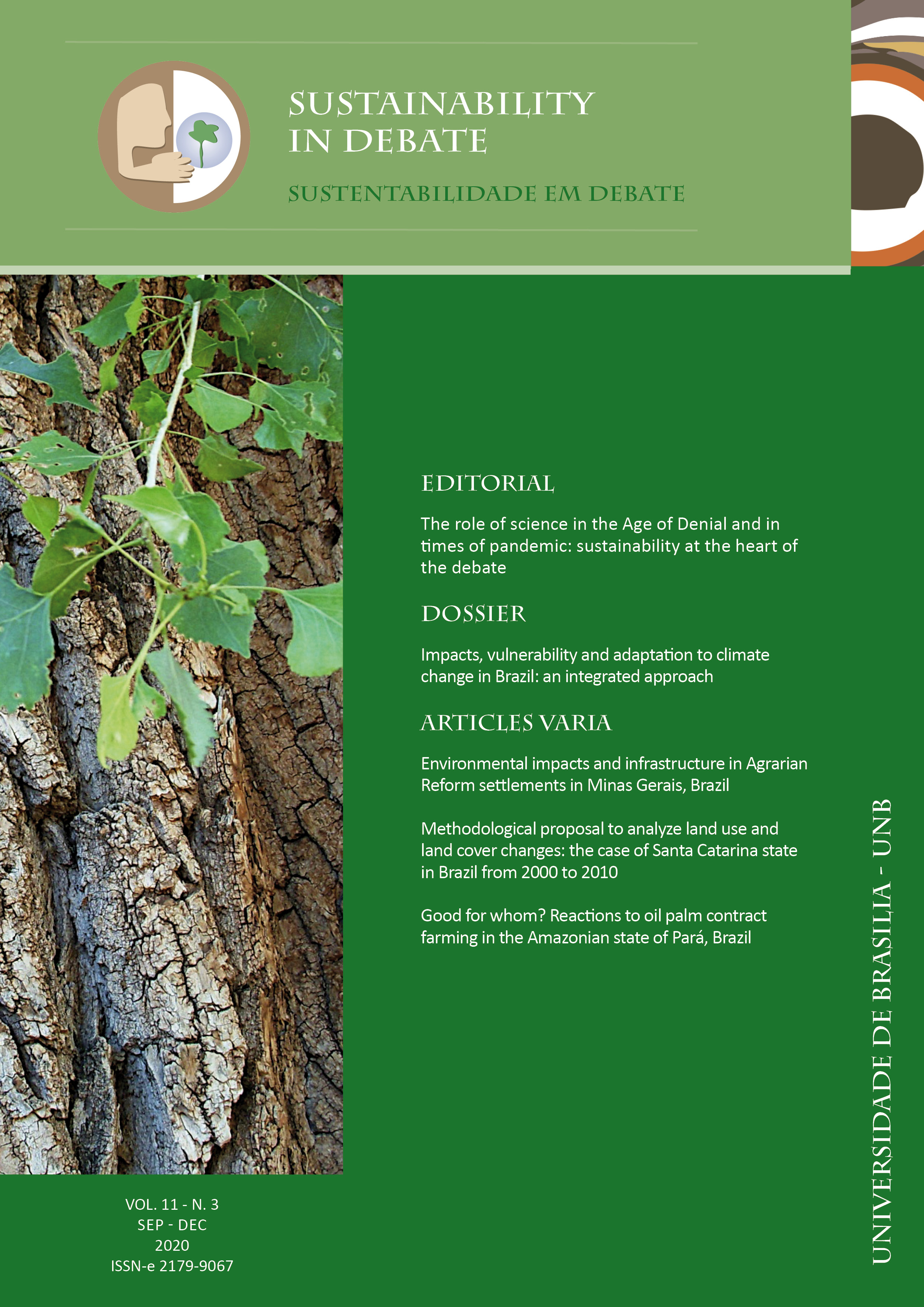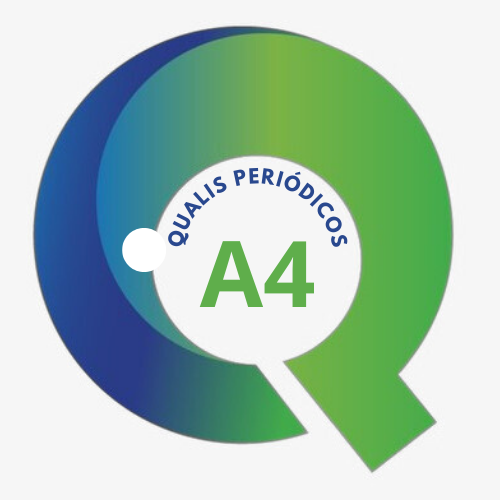Future rainfall and temperature changes in Brazil under global warming levels of 1.5ºC, 2ºC and 4ºC
DOI:
https://doi.org/10.18472/SustDeb.v11n3.2020.33933Resumo
The present study analyzes the impacts of global warming of 1.5ºC, 2ºC, and 4ºC above pre-industrial levels in the Brazilian territory. Climate change projected among the different global warming levels has been analyzed for rainfall, temperature and extreme climate indices. The projections are derived from the global climate model HadGEM3-A, from the High-End cLimate Impacts and eXtremes (HELIX) international project, from the United Kingdom, forced by sea surface temperature and sea ice concentration of a subset of six CMIP5 (Coupled Model Intercomparison Project phase 5) global climate models and considering the RCP 8.5 (Representative Concentration Pathways) emissions scenario throughout the 21st century. Projections indicate robust differences in regional climate characteristics. These differences include changes: in the minimum and maximum air temperature close to the surface to all the country’s regions, in extremes of heat, particularly in northern Brazil, in the occurrence of heavy rainfall (Southern and Southeastern regions), and in the probability of droughts and rain deficits in some regions (Northern and Northeastern Brazil).
Referências
AMBRIZZI, T. et al. Cenários regionalizados de clima no Brasil para o Século XXI: projeções de clima usando três modelos regionais. Ministério do Meio Ambiente (MMA). Secretaria de Biodiversidade e Florestas (SBF). Diretoria de Conservação da Biodiversidade, 2007.
AMBRIZZI, T. et al. The state of the art and fundamental aspects of regional climate modeling in South America. Annals of the New York Academy of Sciences, v. 1436, n. 1, p. 98-120, 2019.
BRASIL. Ministério da Ciência, Tecnologia e Inovações. Terceira comunicação nacional do Brasil à Convenção-Quadro das Nações Unidas sobre mudança do clima. Setor Uso da Terra, Mudança do Uso da Terra e Florestas. MCT, Brasília, DF, Brasil, p. 79, 2016.
CARVALHO, L. M. V.; JONES, C.; LIEBMANN, B. Extreme precipitation events in southeastern South America and large-scale convective patterns in the South Atlantic convergence zone. Journal of Climate, v. 15, n. 17, p. 2377-2394, 2002.
CAVALCANTI, I. F. A. et al. Global climatological features in a simulation using the Cptec ”“ COLA AGCM. Journal of Climate, v. 15, n. 21, p. 2965-2988, 2002.
CHOU, S. C. et al. Assessment of climate change over South America under RCP 4.5 and 8.5 downscaling scenarios. American Journal of Climate Change, v. 3, n. 5, p. 512-525, 2014.
CHOU, S. C. et al. Evaluation of the eta simulations nested in three global climate models. American Journal of Climate Change, v. 3, n. 05, p. 438, 2014.
DÉQUÉ, M. et al. A multi-model climate response over tropical Africa at +2ºC. Climate Services, v. 7, p. 87-95, 2017.
DUNN, R. J. H. et al. Development of an Updated Global Land in Situ”Based Data Set of Temperature and Precipitation Extremes: HadEX3. Journal of Geophysical Research: Atmospheres, v. 125, n. 16, 2020.
ESCOBAR, G. C. J.; MATOSO, V. Zona de Convergência do Atlântico Sul (ZCAS): definição prática segundo uma visão operacional. In: XX CONGRESSO BRASILEIRO DE METEOROLOGIA, 2018, Maceió. Anais… Maceió-AL, 2018.
EYRING, V. et al. Overview of the Coupled Model Intercomparison Project Phase 6 (CMIP6) experimental design and organization. Geoscientific Model Development, v. 9, n. 5, p. 1937-1958, 2016.
FLATO, G. et al. Evaluation of climate models. In: Climate change 2013: the physical science basis. Contribution of Working Group I to the Fifth Assessment Report of the Intergovernmental Panel on Climate Change. Cambridge University Press, 2014. p. 741-866.
FRICH, P. et al. Observed coherent changes in climatic extremes during the second half of the twentieth century. Climate Research, v. 19, n. 3, p. 193-212, 2002.
FUNK, C. et al. The climate hazards infrared precipitation with stations ”“ a new environmental record for monitoring extremes. Scientific Data, v. 2, n. 150066, 2015.
GIORGI, F.; MEARNS, L. O. Introduction to special section: regional climate modeling revisited. Journal of Geophysical Research: Atmospheres, v. 104, n. D6, p. 6335-6352, 1999.
IPCC. Climate Change 2013: the physical science basis. Contribution of Working Group I to the Fifth Assessment Report of the Intergovernmental Panel on Climate Change. STOCKER, T. F. et al. (Ed.). Cambridge University Press, Cambridge, United Kingdom and New York, NY, USA, 1535 p.
IPCC. Global Warming of 1.5°C. An IPCC Special Report on the impacts of global warming of 1.5°C above pre-industrial levels and related global greenhouse gas emission pathways, in the context of strengthening the global response to the threat of climate change, sustainable development, and efforts to eradicate poverty MASSON-DELMOTTE, V. et al. (Ed.). In Press.
JAMES, R.; WASHINGTON, R. Changes in African temperature and precipitation associated with degrees of global warming. Climatic change, v. 117, n. 4, p. 859-872, 2013.
JONES, R. G. et al. Generating high resolution climate change scenarios using Precis. Met Office Hadley Centre, Exeter, UK, v. 40, 2004.
LENNARD, C. J. et al. On the need for regional climate information over Africa under varying levels of global warming. Environmental Research Letters, v. 13, n. 6, p. 060401, 2018.
LIEBMANN, B. et al. An observed trend in central South American precipitation. Journal of Climate, v. 17, n. 22, p. 4357-4367, 2004.
MARENGO, J. A.; AMBRIZZI, T. Use of regional climate models in impacts assessments and adaptations studies from continental to regional and local scales. In: Proceedings of, 2006. p. 291-296.
MARENGO, J. A. et al. An intercomparison of observed and simulated extreme rainfall and temperature events during the last half of the twentieth century: part 2: historical trends. Climatic Change, v. 98, n. 3-4, p. 509-529, 2010.
MARENGO, J. A. et al. Assessment of regional seasonal rainfall predictability using the Cptec/COLA atmospheric GCM. Climate Dynamics, v. 21, n. 5-6, p. 459-475, 2003.
MARENGO, J. A. et al. Development of regional future climate change scenarios in South America using the Eta Cptec/HadCM3 climate change projections: climatology and regional analyses for the Amazon, São Francisco and the Paraná River basins. Climate Dynamics, v. 38, p. 1829-1848, 2012.
MARENGO, J. A. et al. Future change of climate in South America in the late XXI Century: intercomparison of scenarios from three regional climate models (2009) Climate Dynamics. Climate Dynamics. doi:10.1007/s00382-009-0721-6, v. 10.
MORICE, C. P. et al. Quantifying uncertainties in global and regional temperature change using an ensemble of observational estimates: the HadCRUT4 data set. Journal of Geophysical Research: Atmospheres, v. 117, n. D8, 2012.
NAUMANN, G. et al. Global changes in drought conditions under different levels of warming. Geophysical Research Letters, v. 45, n. 7, p. 3285-3296, 2018.
NIKULIN, G. et al. The effects of 1.5 and 2 degrees of global warming on Africa in the Cordex ensemble. Environmental Research Letters, v. 13, n. 6, p. 065003, 2018.
PAL, J. S. et al. Regional climate modeling for the developing world: the ICTP RegCM3 and RegCNET. Bulletin of the American Meteorological Society, v. 88, n. 9, p. 1395-1410, 2007.
PBMC. Base científica das mudanças climáticas. Contribuição do Grupo de Trabalho 1 do Painel Brasileiro de Mudanças Climáticas ao Primeiro Relatório da Avaliação Nacional sobre Mudanças Climáticas. AMBRIZZI, T.; ARAUJO, M. (Ed.). Coppe. Universidade Federal do Rio de Janeiro, Rio de Janeiro, RJ, Brasil, 464 p.
PISNICHENKO, I. A.; TARASOVA, T. A. The climate version of the Eta regional forecast model. 2. Evaluation of the Eta CCS model performance against reanalysis data and surface observations. Disponível em: .1461, 2009.
REBOITA, M. S. et al. Evidências de Circulação de Brisa Vale-Montanha na Serra da Mantiqueira: Cidade de ItajubᔓMG. Ciência e Natura, v. 36, n. 1, p. 61-71, 2014.
REBOITA, M. S. et al. Regimes de precipitação na América do Sul: uma revisão bibliográfica. Revista Brasileira de Meteorologia, v. 25, n. 2, p. 185-204, 2010.
RICHARDSON, K.; BRADSHAW, C. Assessment of the impacts of climate change on national level food insecurity using the Hunger and Climate Vulnerability Index. University of Exeter, 2017.
SATYAMURTY, P. et al. Rainfall trends in the Brazilian Amazon Basin in the past eight decades. Theoretical and Applied Climatology, v. 99, n. 1-2, p. 139-148, 2010.
SCHWINGSHACKL, C.; HIRSCHI, M.; SENEVIRATNE, S. I. Global Contributions of Incoming Radiation and Land Surface Conditions to Maximum Near”Surface Air Temperature Variability and Trend. Geophysical research letters, v. 45, n. 10, p. 5034-5044, 2018.
SILVA, J. P. R.; REBOITA, M. S.; ESCOBAR, G. C. J. Caracterização da Zona de Convergência do Atlântico Sul em Campos Atmosféricos recentes. Revista Brasileira de Climatologia, v. 25, 2019.
SIMMONS, A. J. et al. A reassessment of temperature variations and trends from global reanalysis and monthly surface climatological datasets. Quarterly Journal of the Royal Meteorological Society, v. 143, n. 702, p. 101-119, 2017.
SOLMAN, S. A. et al. Evaluation of an ensemble of regional climate model simulations over South America driven by the ERA-Interim reanalysis: model performance and uncertainties. Climate Dynamics, v. 41, n. 5-6, p. 1139-1157, 2013.
VUUREN, D. P. van et al. RCP2.6: exploring the possibility to keep global mean temperature increase below 2ºC. Climatic Change, v. 109, n. 1-2, p. 95-116, 2011.
VAUTARD, R. et al. The European climate under a 2°C global warming. Environmental Research Letters, v. 9, n. 3, p. 034006, 2014.
WALTERS, D. et al. The Met Office unified model global atmosphere 6.0/6.1 and Jules global land 6.0/6.1 configurations. Geoscientific Model Development, v. 10, n. 4, p. 1487-1520, 2017.
WBGU. Scenario for the derivation of global CO2 reduction targets and implementation strategies. WBGU, Bremerhaven, Germany. 1995.
WYSER, K. et al. Documentation of changes in climate variability and extremes simulated by the Helix AGCMs at the 3 GWLs and comparison in equivalent SST/SIC low-resolution CMIP5 projections. HELIX Project Deliverable 3.1. 2017.
Downloads
Publicado
Edição
Seção
Licença
Copyright (c) 2020 Sustentabilidade em Debate

Este trabalho está licenciado sob uma licença Creative Commons Attribution-NonCommercial-NoDerivatives 4.0 International License.
A submissão de trabalho(s) científico(s) original(is) pelos autores, na qualidade de titulares do direito de autor do(s) texto(s) enviado(s) ao periódico, nos termos da Lei 9.610/98, implica na cessão de direitos autorais de publicação impressa e/ou digital à Revista Sustentabilidade em Debate do(s) artigo(s) aprovado(s) para fins da publicação, em um único número da Revista, autorizando-se, ainda, que o(s) trabalho(s) científico(s) aprovado(s) seja(m) divulgado(s) gratuitamente, sem qualquer tipo de ressarcimento a título de direitos autorais, por meio do site da Revista, para fins de leitura, impressão e/ou download do arquivo do texto, a partir da data de aceitação para fins de publicação. Portanto, os autores ao procederem a submissão do(s) artigo(s) Revista, e, por conseguinte, a cessão gratuita dos direitos autorais relacionados ao trabalho científico enviado, têm plena ciência de que não serão remunerados pela publicação do(s) artigo(s) no periódico.
A Revista encontra-se licenciada sob uma Licença Creative Commons Atribuição-NãoComercial-SemDerivações (Proibição de Realização de Obras Derivadas) 3.0 Brasil, para fins de difusão do conhecimento científico, conforme indicado no sítio da publicação, que permite o compartilhamento do texto e o reconhecimento de sua autoria e publicação original nesta revista.
Os autores têm permissão para assumir contratos adicionais separadamente, para distribuição não-exclusiva dos trabalhos publicados na Revista Sustentabilidade em Debate (por exemplo, em um capítulo de livro), desde que seja assinalado que os textos foram originalmente publicados nesta revista e que seja mencionado o DOI correspondente. Os autores têm permissão e são estimulados a publicar e distribuir o seu texto online, após a publicação (por exemplo, em repositórios institucionais ou nas suas páginas pessoais).
Os autores declaram expressamente concordar com os termos da presente Declaração de Direito Autoral, que se aplicará a submissão caso seja publicada por esta Revista.









